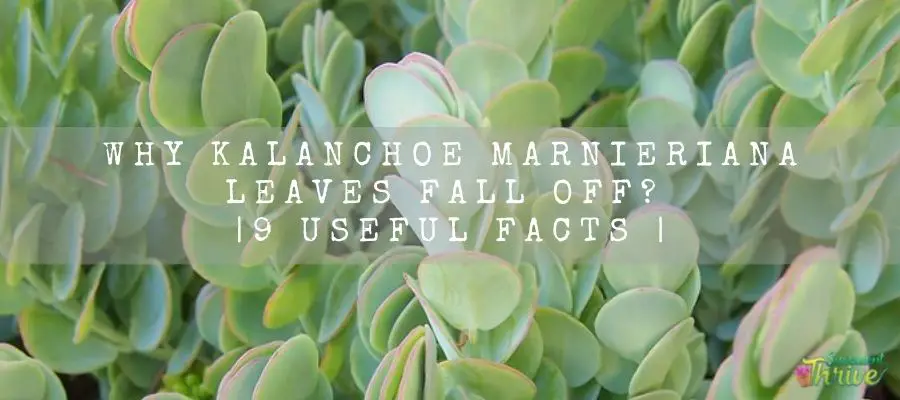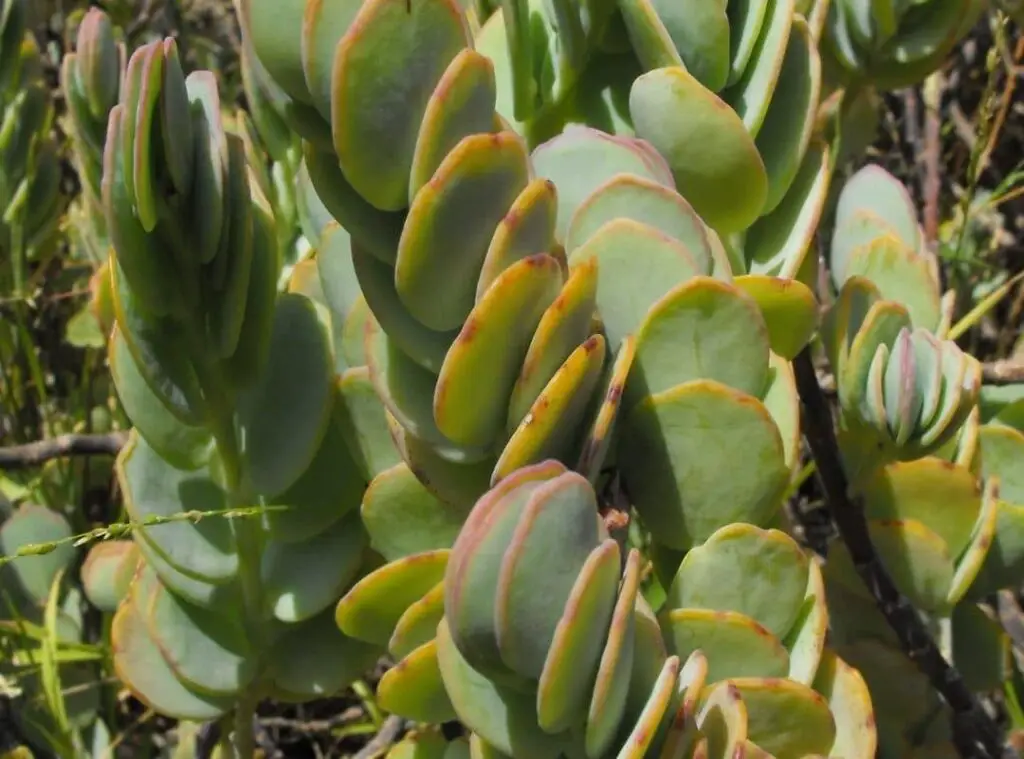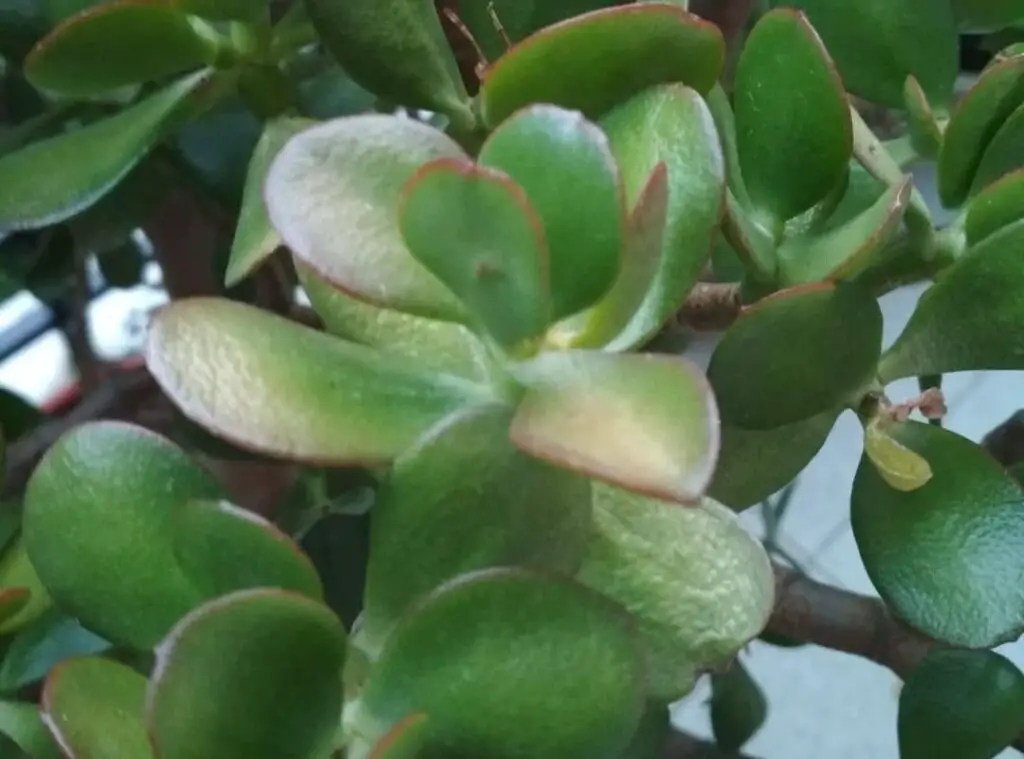Kalanchoe marnieriana leaves fall off due to several reasons. It could be due to lack of nutrients, incorrect soil mix, lack of sunlight or even due to a pest attack.
Last but not least, they falloff their leaves due to improper watering methods and due to getting exposed to extreme temperature conditions too. Lets us discuss possible reasons one by one

Lack of Light
If you fail to provide the adequate level of sunlight, that will make them drop Kalanchoe marnieriana leaves .
As such, It is necessary to provide indirect sunlight and partial shade for these plants to thrive well. You need to provide a lot of indirect sunlight for them to avoid them going through the etiolation condition.
Best is to expose them for about 6 hours of indirect sunlight, and you could locate them in a partial shade area for the rest of the day.
If the winter weather conditions are forecasted, you may bring the plants indoors and locate them near a bright sunny window.
Furthermore, you may locate these kalanchoe plants in a shady place and they could thrive in those conditions better than the rest of the other types.
However, it is important that you do not expose them to direct sunlight as it could affect the plant’s leaves to fall off.
In addition to that, if you fail to provide adequate sunlight levels, they will tend to shed Kalanchoe marnieriana leaves .
Improper watering
Moreover, improper watering methods could also cause these succulents to drop Kalanchoe marnieriana leave .
If you supply the plants with excess water, that will make these plant leaves swollen. In addition to that they would get mushy and soft to the touch as well. Eventually, they will end up getting fallen from the plant.
Temperature control
If you expose the Kalanchoes to intense temperatures, it will also affect them to drop their Kalanchoe marnieriana leave .
Ideally, they should have a temperature range from 20 degrees Celsius to 29 degrees Celsius for them to have optimal growth.
Do not expose them to freezing temperatures for a prolonged period as that could be fatal to them. They would prefer to grow in USDA zones 9a-11b and they would grow as a hardy plant in those conditions.
In addition to the aforesaid, if you expose the kalanchoe plants to intense heat, those conditions will also make them drop their leaves.
They do this as a responsive method of those harsh dry and heated conditions. Once they do this, that will help them to save their energy and consequently they could retain their water too.
As such, you need to take necessary actions to safeguard the plant, especially during any heat wave conditions. Best is to shift them indoors and protect the plant. Unless the plant will have to suffer from Kalanchoe marnieriana leave shedding.
Chemicals effect
Chances are that kalanchoe leaves could fall off due to chemicals as well. In terms of fertilizing these plants, it is essential that you do it only once a month.
Kalanchoes in general do not depend on a lot of fertilizers. However, when you feed them as appropriate and occasionally it would enhance the growth.
You could utilize any fertilizer type which is recommended for succulents. Many people use a complex fertilizer in order to stimulate the flowering.
When you use the fertilizers, always ensure that you use them only at half a dose of prescribed doze.
If you supply an excess number of fertilizers that would badly affect the plant’s well being and would cause the plant to drop its leaves.
Best is to feed them during their flowering season. Moreover, you need to choose a balanced fertilizer of 20:20:20 so that it will not cause any overabundance of chemicals which would cause the plant to deteriorate and to drop their leaves.
If you are an organic lover, you may use a top dressing on compost during every spring.
Seasonal changes
These kalanchoe plants go dormant in the summer season. Kalanchoe marnieriana is considered as a deciduous perennial succulent type which would lose its foliage and go dormant during summer.
Once this happens, Kalanchoe marnieriana leaves fall off in response to dormant growth.

How kalanchoe marnieriana leaves looks like
Healthy leaves
Kalanchoe marnieriana is a succulent subshrub and it is an evergreen succulent type. When they grow healthily, you could spot them growing blue green in color and rounded in shape.
On the other hand, their leaves would mimic a paddle shape and you could spot them developing oppositely.
Moreover, they tend to look like clam shells. What is more special about these healthy leaves is that they have vibrant red wine tips on the leaves. You could spot them with those tips, especially during winter months when the weather conditions are much chiller.
Unhealthy leaves
Once the kalanchoe plant is unhealthy, you could identify that from looking at the unhealthy leaves. You could identify them if they are yellow or brown in color.
Apart from that, they could be wrinkled too. Apart from those colors in the leaves, they would be soft to touch as well.
Further they would be translucent and mushy and shriveled too. If you had supplied an excess amount of water, chances are that you could spot the leaves even in black. That is mostly probable when the plant is suffering from root rots.
Should I remove unhealthy leaves from succulents?
Best is to remove the unhealthy leaves from the kalanchoe plant. if you realize the leaves have become unhealthy due to a pest attack, make sure that you remove the spent or the dying flowers.
It will stimulate the plant to develop new growth vigorously and faster too. Furthermore, it will stimulate the flower blossoming more in the upcoming season as well.
In addition to that, once you take off all these dying and unhealthy leaves that would give a tidy and a neat look for the plant as well.
This will cause them to have good health and will be able to maintain their well being as well. Moreover, they could save their energy as they do not have to sustain those unnecessary leaves too.
When you remove these unhealthy leaves, make sure that you use clean and sterilized sharp equipment to trim them off. When you do this, make sure that you do not harm the rest of the plant and only remove the unwanted and unhealthy leaves.

Can you stop leaves falling off?
You could stop leaves falling from the Kalanchoe plant if you practice the following guidelines.
- Water them thoroughly. Always make sure the soil is entirely dry before you water them. Make sure you are growing these plants in a well-draining potting mix, and you do not let the plants stand in soggy and dam conditions. On the other hand, if the plant is not getting adequate water, you need to immediately commence watering them.
- Safeguard your plant from intense sunlight or from heatwave or from drought conditions. During this time, you need to water them more . Alternatively, you could shift them to a shady place.
- You need to report the plants when it is essential. You may use a balanced fertilizer and a well-draining soil mix for this purpose. Best is to use a cactus mix or a succulent mix.
Can you save the kalanchoe plant which lost all its leaves?
Yes most of the time you can save your Kalanchoe marnieriana plant though they lose all their leaves as they could regenerate. They could do this only if their roots are healthy and not rotten.
Conclusion
- There are several reasons for Kalanchoe marnieriana leaves to fall off.
- If you notice that your kalanchoe plant’s leaves are drooping due to a shortage of nutrients, you need to feed them as appropriate.
- If you notice that your plant’s leaves at the base tend to fall rapidly and, in the meantime, if the leaves at the top are turning yellow, that could be due to the shortage of adequate sunlight.
- To remedy this, you could immediately expose them for adequate sunlight. Best is to place them by a window.
- You need to deal with pests such as mealybugs and with mollusks when you are growing these succulents.
- You could spot the mealybugs as white little cottony substances which could be seen jumping when you interrupt them.
- They would stimulate fungal growth of the plant. They could also attribute the Kalanchoe marnieriana leaves to fall off.
- It is an indication the plant gives to notify that the plant is under attack by a fungus or by a bacteria.
- In terms of watering these kalanchoe plants, it is crucial that you water them properly. Unless chances are that they could start dropping their leaves.
- In addition to the aforesaid, if you expose the kalanchoe plants to intense heat, those conditions will also make them drop their leaves.
- They do this as a responsive method of those harsh dry and heated conditions. Once they do this, that will help them to save their energy and consequently they could retain their water conservation too.
Read Next: Kalanchoe Marnieriana Pruning | 4 Steps Paths To Follow
